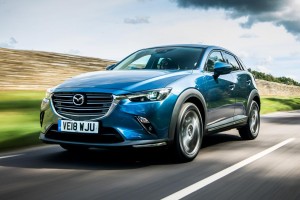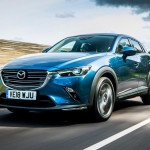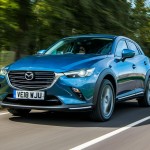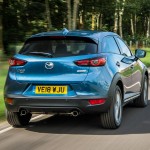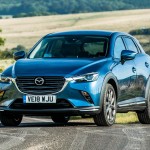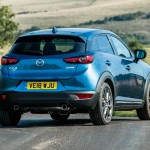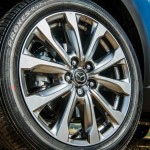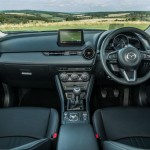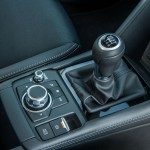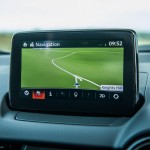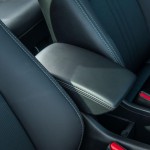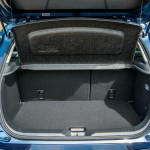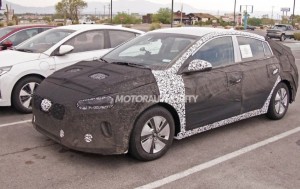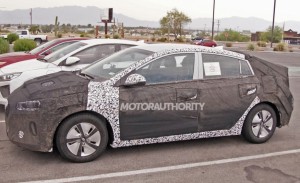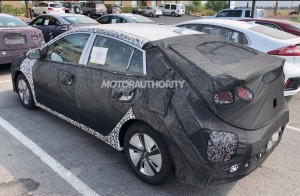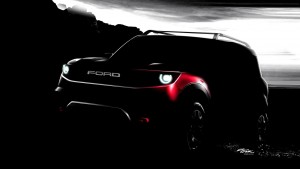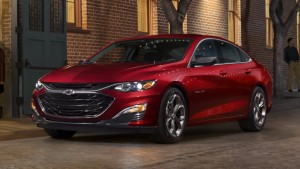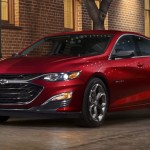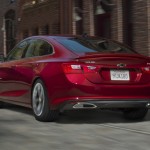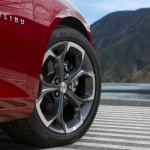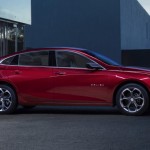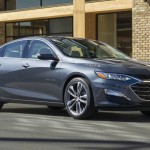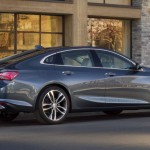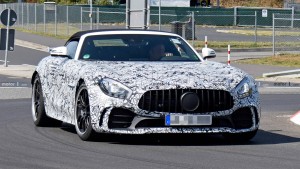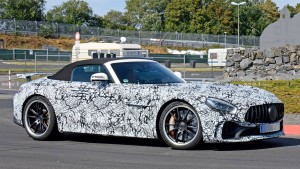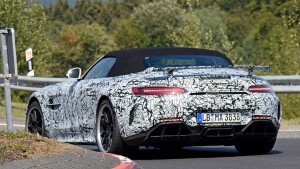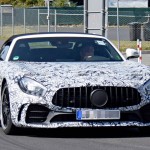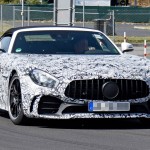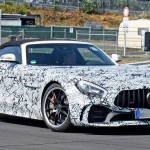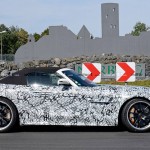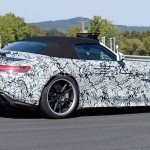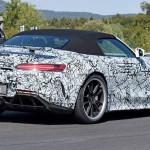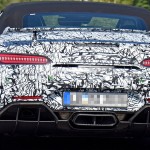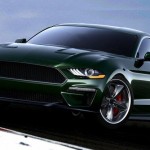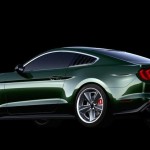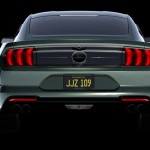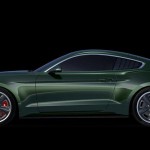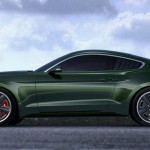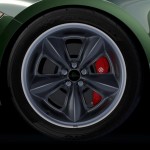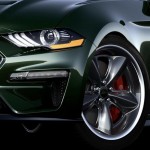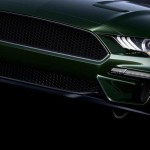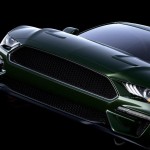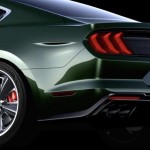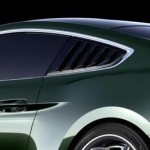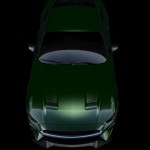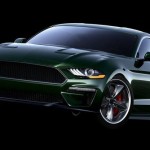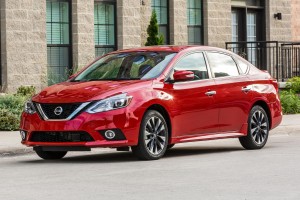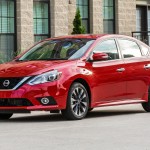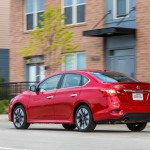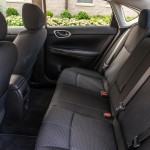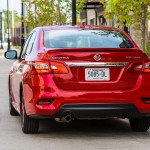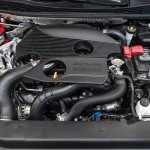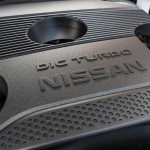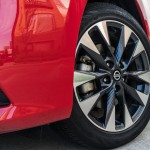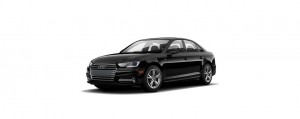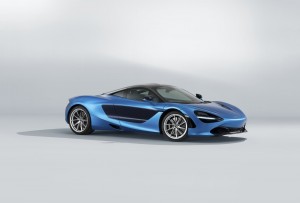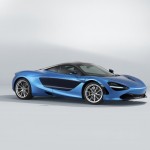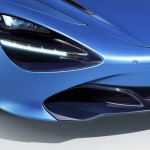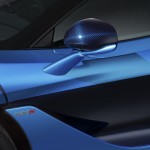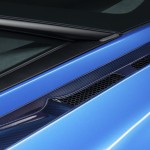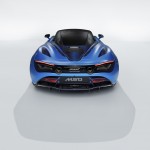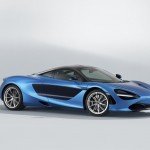Monthly Archives: August 2018
Revised Mazda CX-3 Gets Mechanical Upgrades
The facelift for the Mazda CX-3 focuses less on styling and cosmetics and more on the mechanical side of the upgrade. It gained minimum changes to its styling and interior, but more was done on the suspension and engine lineup.
As a rival to the Nissan Kicks, the Mazda CX-3 styling enhancements are very minimal: a touched-up grille and darker pillar trims are the most obvious change. Aside from that, nothing else seems to have been touched by the Japanese automaker. Inside, Mazda ditched the manual handbrake with an electrical item. It freed up space enough for the repositioned infotainment controls, a central armrest, and a cubby space beneath.
Making the front seats more supportive is more padding while the rear seats have a folding center armrest with cupholders. According to Mazda, there are other features such as a thicker roof lining, sound insulation in the doors, and revisions to the door sill trims and rear glazing.
The biggest change can be seen in the mechanical upgrades. Mazda overhauled the springs, dampers, and front anti-roll bar on the new CX-3. Together with a revised steering system, the 2018 CX-3, which was already a fun mini SUV to drive, will ride and handle better than its predecessor.
The engine lineup has gotten a bit of a shake. Though the petrol engines remain the same: a 2.0-liter unit that can produce 119 or 148 horsepower. But the recent adjustments to the pistons and injectors will improve the torque and fuel economy. The previous 1.5-liter diesel was replaced by a 1.8-liter unit, which now makes 113 horsepower, 10 horses more than the current model.
The diesel and the 119-horsepower petrol are paired with a front-wheel drive while the 148-horsepower is an all-wheel drive only.
The revised CX-3 is available starting August 31. The price for the base model is $24,484.46.
2020 Hyundai Ioniq Spy Shots Show New Grille, Design Language
A prototype for the updated version of the Hyundai Ioniq has been spotted testing its hot weather capabilities in California’s Death Valley. This confirms reports that Hyundai is updating its Ioniq family of hybrid and electric cars.
The Ioniq was first introduced in 2017 so this updated version should come to us next year as a 2020 model bearing a slew of midcycle facelifts for Toyota Prius’ competitor.
Based on the spy photos, the Ioniq will receive some major updates for the exterior. The car was heavily camouflaged but not thoroughly enough that we’re able to make out the car’s new mesh pattern for the grille (instead of the current horizontal slats on the current model). The internals of the lights is also new.
The prototype the spy photographers took was either the Ioniq Plug-in Hybrid or the Ioniq Hybrid, though most of the changes should be applied across the range.
We expect that the car’s design will be tweaked to feature elements found on Hyundai’s Le Fil Rouge concept, which was unveiled at this year’s Geneva auto show in March. The concept was focused on Hyundai’s new “sensuous sportiness” design language. The elements of this concept are scheduled to first appear in a production model through the redesigned Sonata next year.
Hyundai hasn’t been clear about changes to its drivetrains, but there should be major updates considering the developments we’ve had in the electrification technology. The Ioniq Hybrid and the Ioniq Plug-in Hybrid are closely related since they both feature a 1.6-liter inline-4 as their internal combustion. They also share a single electric motor paired with a six-speed dual-clutch transmission. That combination can make 139 horsepower and the plug-in hybrid can go 29 miles on electric power alone.
On the other hand, the Ioniq Electric can power up to 120 horsepower from a single electric motor. That alone can cover 124 miles on a single charge of its 28-kilowatt-hour lithium-ion battery.
3 Things That Explain The Hype Behind The Ford Baby Bronco
In March 2018, Ford revealed its two-year plan to release new models, a majority of which would be SUV crossovers. One of the biggest news is the hybrid version of the F-150 and the revival of the iconic Bronco. But that’s not all because we are hearing reports that there would be a smaller sibling to the Bronco II or the “Baby Bronco.”
Exterior
The rendering of the Baby Bronco showed that it will compete with the Jeep, particularly the Renegade. The first thing that will catch your eye is the boxy shape—from the front fascia down to the rear fascia (though that one isn’t clear yet). There’s a wide grille that runs between the headlamps and the big “Ford” lettering could clearly be seen.
Speaking of headlamps, the units are round and simple but features LED technology. The bumper looks very basic with a simple grille and possibly LED foglamps on each side. Thick cladding can also be seen on the fenders. Other features would be its tall ride height and the rack on the roof.
Interior
It’s difficult to say how the Baby Bronco will look in the inside since Ford plans to reveal it in 2021. That’s a lot of time for the company to introduce a new design language. That being said, the Baby Bronco should be able to give the Renegade a run for its money.
There should be ample seating for five adults. The Renegade has good legroom and headroom rating for the rear-seat passengers at 40.5 inches and 35.1 inches, respectively, so Ford should try to top that off. The company should also match the 45.3 cubic feet trunk of the Renegade.
Drivetrain
The Baby Bronco might have the same engine options as the Escape as it is slated just above the EcoSport. In the US, the Escape is being offered in three four-cylinder gasoline engines that can produce somewhere between 168 horsepower (for the base model) and 245 horsepower (for the top-of-the-line model).
2019 Chevrolet Malibu RS Commands A $24,995 Price
At this year’s New York Auto Show, Chevrolet announced that its 2019 Chevrolet Malibu RS, the brand’s sporty sedan, should sell for $25,000. Reports recently find a buying guide that shows the package for the midsize sedan will be priced at $24,120 plus an $875 destination charge. That’s a total of $24,995.
The Malibu RS will exactly be $1,000 less than the lower LS trim, which sells $23,995 after the destination charge.
The Malibu RS, together with all the other 2019 Malibu lineup, will have reworked front and rear fascias. Its 1.5-liter turbocharged four-cylinder will produce 163 horsepower and 184 pound-feet of torque will be paired with a CVT instead of the six-speed automatic in the current model. This is the brand’s first use of the CVT in a non-hybrid model aside from the subcompact Spark.
Once inside the cabin, you will notice that the infotainment screen grew by an inch to a total of eight inches and the Malibu RS will also enjoy the brand’s Infotainment 3 system. The steering wheel is going to be wrapped in leather. The shift knob will also get the same treatment to complement the black cloth seats.
And that’s not all because the 2019 Malibu RS will also add a black sport grille and black Bowties, black mirror caps, a rear spoiler, dual exhaust, and 18-inch wheels to wrap off the new look.
The Malibu RS is Chevrolet’s entry into the field of aggressive mid-size sport sedans. Pricing it under $25,000 is a smart move considering that the Toyota Camry SE sells for $26,470 and the Honda Accord Sport is priced at $26,675. However, the sporty Mazda 6 Sport lies beneath the Malibu RS with a $23,895 price tag.
By comparison, the 2019 Ford Fusion is selling for $32,065 and the 2019 Dodge Charger for $28,995.
3 Things We Learned About the 2019 Mercedes-AMG GT R Roadster
Mercedes-AMG is finally making a top-down version of the GT R—following the footsteps of the GT C version and the GT S Roadster. There have been rumors that the Germans are planning a top-down version of the Mercedes-AMG GT R, and now, it looks like they are coming true.
Spy shots of the 2019 Mercedes-AMG GT R Roadster have been leaked as the car made its first testing session.
1. Exterior
The GT R Roadster will be similar to the coupe version from the waist down. The AMG grille with chromed out vertical slats and big Mercedes emblem are very recognizable even through the camouflaged photos.
The big difference will be with what happens from the waist up. There will be a soft top, of course, as well as modifications at the rear deck. The windshield will be shorter and fully framed, there will be no rear quarter glass, and there will be roll bars behind the seats for safety purposes.
2. Interior
The interior of the GT R Roadster will be identical to the coupe, except for the unlimited headroom during open-air drives and the roll bars behind the rear seats. There will be two, manually-adjustable bucket racing seats with AMG lettering and contrasting seatbelts, flat-bottom steering wheel, and a digital instrument cluster. All of these are wrapped with Nappa leather and Dinamica microfiber treatment. There will also be a large infotainment display at the center of the stack.
3. Drivetrain
The GT R Roadster will have a similar powertrain as the coupe version, except that its 4.0-liter Biturbo V8 engine will make 577 horsepower and 516 pound-feet of torque. That’s an increase of 74 ponies and 35 pound-feet of torque over the same engine in the GT S. The Roadster will be a bit slower in reaching the 60-mph sprint by 0.1 seconds. The coupe can reach this by 3.5 seconds while the GT R Roadster will likely take 3.6 seconds. The top speed is estimated to be at 198 mph.
What To Expect From Steeda’s Ford Mustang Bullitt
The tuner Steeda is known for its affection for the Ford Mustang, and it has become famous when it comes to creating limited and special edition of the car for many clients. For the Mustang Bullitt, the company partnered with Galpin Auto Sports and McQueen Racing to deliver the most amazing version of the auto to date.
Exterior
The stock Ford Mustang Bullitt is cool enough in terms of looks, but the Steeda package adds another level of prestige factor. The Steeda-built Bullitt gets an all-new aerodynamic package that includes a deeper front splitter, side skirts, and rear diffuser. To make it look more exciting, Steeda adds another inch to the tuner’s signature wheels and finished all the additional pieces in Highland Green.
Interior
Moving past the exterior features, the Steeda’s Bullitt is fitted with a multitude of McQueen plaques, Alcantara steering wheel, and leather-covered surfaces all over. Steeda did not give any details about the other changes they did to the Mustang Bullitt, but we’re excited to see more.
Performance
Steeda integrates the Bullitt with a 2.9-liter Whipple supercharger, which leads to the modifications on the rear suspension and axles plus a carbon driveshaft. It also offers optional extras that include four-point roll cage and rear seat delete, Ford performance severe duty IRS half-shaft upgrade, and McQueen racing brake calipers painted in dark charcoal with McQueen accents in green.
You can opt for the stock Bullitt, but if you want the ultimate experience, you can shell out some serious cash on the Steeda-tuned Bullitt. The options for the power output are quite extensive—a 500-horsepower beast or an 800-horsepower Hellcat killer.
The Ford Mustang Bullitt sells for $46,595. The Steeda package costs an additional $20,995. The price is steep but the Steeda package can power the Bullitt by 800 horsepower, so you can compete against the meanest muscle cars on the road.
What We Know So Far About The Peugeot 2008 Baby SUV

2019 Peugeot 2008 photo by AutoExpress.
Peugeot’s two latest SUVs, the 3008 and the 5008, were both warmly welcomed by the auto community, which might be the trigger for the French company to introduce the two models’ baby brother, the 2008. Due to be revealed in the autumn of 2019, the Peugeot 2008 will carry the brand’s newest chassis technology developed by its parent firm, the PSA, and its Chinese partner, DongFeng.
The new chassis platform is called the CMP or the Compact Modular Platform, which was specifically designed for smaller cars. It will make its new debut on the new 208, which we can expect at the Geneva Motor Show next year.
The new platform will make the 2008 SUV slightly longer but lighter than the outgoing model. The CMP chassis weighs around 40 kilograms less than the PF1 setup that is used in the existing 208 and 2008 lineups.
The company has been working hard to ensure that there are consistency and sophistication in their designs, so we can expect the new 2008 to be similar in looks with the new 208. That would, of course, bring a lot of changes and updates to the bigger 3008.
Inside the cabin, more premium materials will be used for that topnotch experience. There should be a totally redesigned dashboard featuring the latest evolutions in Peugeot’s i-Cockpit instrument panel. These changes will extend to the fully digital display across the range, specifically in regions like the UK where Peugeot is being considered at the “upper end of mainstream.”
As for the engine lineup, the 2008 should be using an updated form of the current 1.2-liter PureTech petrol motor that can deliver somewhere from 85 to 130 horsepower. Aside from the petrol engines, the 2008 should get the PSA’s new-generation 1.5-liter BlueHDi diesel engines, an eight-speed automatic for high-end variants, and a standard six-speed manual.
Top 3 Things To Know About The 2019 Nissan Sentra
The Nissan Sentra is not exactly the type of compact sedan that car enthusiasts love. It has nothing going on except that it’s dependable and it does the job well. The functionality, however, of the Sentra proved to be Nissan’s reason to go as far as release a Nismo version a few years back.
1. Entry-Level Model Is More Expensive Than Its Predecessor
The entry-level Sentra S is $1,100 more expensive than its predecessor. It comes in at $17,790 and gets a few basic pieces of equipment such as air-conditioning, Bluetooth connectivity, powered windows/locks, and cruise control. The base model also comes with a 1.8-liter engine that makes 124 horsepower with the Xtronic transmission and 130 horses with a six-speed manual.
Moving up the trim level, the Sentra SV includes a 7.0-inch NissanConnect infotainment system with an Apple CarPlay and Android Auto connectivity. The SV option also gives you a chance to pay for the SV Special Edition Package.
2. SV Special Edition Package Is New To The Game
The SV Special Edition Package was made exclusively for the SV trim level. It offers a whole lot of aesthetic materials that could make the Sentra stand out. For example, the package will include 17-inch aluminum-alloy wheels, rear disc brakes, Blind Spot Warning (BSW), Rear Cross Traffic Alert (RCTA), Intelligent Cruise Control (ICC), power sliding glass moonroof with tilt feature, center room dim lamp (LED), dual illuminated visor vanity mirrors, and a Special Edition badge.
The SV Special Edition Package will also come with the Xtronic transmission, meaning that the Sentra will get the automatic emergency braking system.
3. Sentra SR Turbo And Sentra Nismo Are Also Available
If you are not satisfied with the kind of performance that the S and the SV can provide, maybe you should look into the SR Turbo and Nismo trim levels. They are the only ones available with the 1.6-liter turbocharged engine.
Overall, the new Nissan Sentra is also boasting of its Safety Shield Technologies that include Automatic Emergency Braking, Intelligent Cruise Control, Blind Spot Warning, and Rear Cross Traffic Alert.
2019 Audi A4 and A5 Lose Manual Transmission
Audi has confirmed that its A4 and A5 will drop the manual transmission option for the 2019 model year. The company cited low sales as the reason for killing the stick-shift option.
Since it debuted in 2017, the A4 had a six-speed manual transmission but Audi has experienced a slump in sales and customer satisfaction rating that even its A5 coupe lost the manual gearbox. This means that Audi’s lineup would be completely manual-free in the United States.
Only a handful of Americans, about 5 percent, chose the A4’s manual transmission over its seven-speed, dual-clutch transmission. This is enough reason for the company to pull out the manual option from the sedan, of course. Car experts are certainly disappointed because the manual transmission made the cars more powerful and it provided an increased level of performance.
During a test, a manual A4 can sprint from 0 to 60 mph in just 5.1 seconds, a tenth of a second quicker than an A4 that runs on a dual-clutch automatic transmission.
It did make sense for Audi to finally pull out all the manual transmission options from its lineup as it moves toward a more “electrified” future. The shift to electric cars by virtually every carmaker in the world is another consideration that must have come into play in Audi’s decision.
If you still want a manual Audi, you can go to dealerships nationwide as some of the 2018 models are still available. Provided that the six-speed manual transmission was only offered with Quattro all-wheel drive and the standard 252-horsepower 2.0-liter turbo four, owning one of these last remaining manual cars is still cool.
The 2019 model year should be available in dealerships later this year for $36,975, so go get your hands on those manual cars while you still can.
3 Things That Make The 2018 McLaren 720S Pacific Theme Extra Special
The McLaren 720S was unveiled back in 2017 as a replacement for the 620S. Its aggressive design, luxurious interior, and the powerful engine have been the talk of the auto industry for quite some time. Since then, McLaren has become fond of introducing custom models by MSO division, starting with the Velocity Theme.
This August 2018, the Brits have come up with two mode special editions—the Track Theme and the Pacific Theme. Let’s look at the latter, which boasts of a stunning color and sophisticated luxury. But before falling in love with the Pacific Theme, we should warn you that this is only available in Scotland, where it was commissioned by McLaren Special Operations for McLaren Glasgow.
Cerulean Blue
If you think the McLaren 720S Pacific Theme looks stunning from afar, that’s nothing compared to when you’re actually looking at it closely. The car boasts of three special shades of blue, starting with Cerulean Blue that covers most of the body. This particular shade combines light and bright hue, which will remind you of the Pacific Ocean. It also helps the 720S stand out from the rest of the pack.
Estoril Blue
Most cars have black door inserts. What this theme did is to fit it with Estoril Blue elements. The paint is darker, giving a striking contrast with the fenders and the rest of the body.
Cobalt Blue
The third shade of blue is called Cobalt Blue, and it is actually a tint for the exposed carbon fiber. It’s a really dark shade and you will notice it painted on the front splitter, air intakes, mirror caps, rear diffuser, deck lid, rear bumper, engine cover, and roof. These elements are finished in carbon fiber.
The 720S Pacific Theme comes with a set of silver wheels and grey brake calipers. The silver, of course, works nicely with the bright Cerulean Blue.

